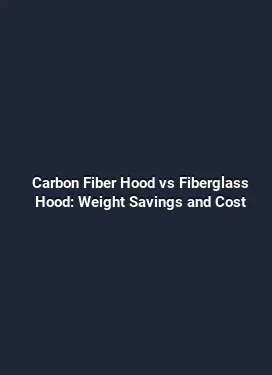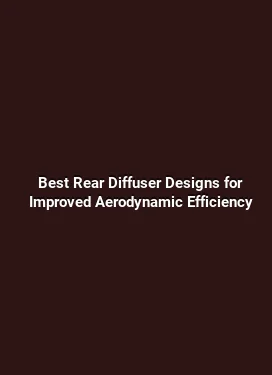Carbon Fiber Trunk Lid Installation with Integrated Wing Mount: A Practical Guide for Body & Aerodynamics
The choice to upgrade a vehicle’s trunk lid with a carbon fiber component that includes an integrated wing mount is driven by a blend of aesthetics, weight savings, and aerodynamic gains. This guide walks through the installation process, material considerations, alignment principles, and performance implications so builders can achieve a clean, functional integration. Emphasis is placed on real-world steps, tooling, and tuning that help ensure the upgrade complements the vehicle’s handling, balance, and airflow behavior.
Material Selection and Preparation: Understanding the Core Components

Carbon fiber trunk lids come in various layups and resin systems. The choice affects rigidity, flex under load, and how the integrated wing mount interfaces with the lid and the surrounding structure. A common approach uses a prepreg or out-of-autoclave (OOA) layup with a tuned thickness that balances rigidity with weight.
Key considerations include cure temperature compatibility with the vehicle’s existing paint and adhesive systems, moisture resistance, and the potential for thermal expansion differences between the carbon fiber component and the metal or composite hood. A well-matched prep stage ensures that during curing, the outer finish remains free of resin-rich pockets or voids that could compromise surface quality and long-term durability.
Structural Interface and Load Path Understanding

When integrating a trunk lid with an embedded wing mount, the primary concern is how aerodynamic loads transfer from the mounted wing through the lid to the chassis. The wing’s downforce or upforce creates a multi-directional load path that must be managed by fasteners, adhesive bonds, and reinforcement at attachment points. Designers often incorporate a dedicated doubler or bonded base plate at the wing region to distribute load and reduce localized stress concentrations.
Metallic reinforcements, compatibility between fasteners, and the stiffness of the trunk opening frame all contribute to a predictable load path. Engineered inserts, such as threaded inserts or stitched-in composite anchors, are used to avoid over-stressing resin-rich areas. Properly accounted-for load paths improve longevity and reduce the risk of wing-tap or lid flutter at high-speed airflow.
Precise Mounting and Alignment: Achieving a Flush, Aerodynamically Sound Fit
Mounting a trunk lid with an integrated wing mount requires meticulous alignment to preserve the vehicle’s silhouette and to maintain consistent edge gaps. A precise fit reduces drag irregularities and avoids premature wear on seals and hinges. Start with a clean, dry surface and verify that the mounting hardware matches the chosen attachment strategy—whether it relies on factory hinge points, an aftermarket hinge system, or a hybrid approach combining mechanical fasteners with structural adhesives.
Alignment procedures typically involve establishing a baseline plane for the lid, then refining the wing mount’s position to ensure the wing sits parallel to the body and at the intended height. A common practice is to use a string or laser reference across the rear deck to measure gaps and ensure optical continuity with the trailing edges. Minor adjustments to the wing’s cant, rake, and dihedral angle can significantly influence the overall aerodynamic balance and ingress of lateral air around the trunk region.
Fastening Strategies: Mechanical and Bonded Solutions
A robust integration often combines mechanical fasteners with structural bonding. Mechanical fasteners provide immediate clamping force and repeatable alignment, while adhesives distribute the load more evenly across the mounting surface. The choice between self-tapping fasteners, through-bolts, or blind fasteners depends on accessibility, substrate material, and the anticipated service life.
Adhesive selection should consider the operating environment, including temperature swings, exposure to UV, and potential chemical exposure from road grime or cleaning agents. A high-performance epoxy or structural adhesive with a proven track record in automotive applications can create a strong bond to both carbon fiber and metallic surfaces, ensuring the wing mount remains secure under dynamic loads at speed.
Aerodynamic Implications: How the Trunk Lid and Integrated Wing Shape Influence Performance
The aerodynamic impact of a carbon fiber trunk lid with an integrated wing mount extends beyond visual appeal. The combination of a lighter deck and a wing that is precisely positioned can alter the vehicle’s center of pressure, downforce distribution, and overall stability. A thoughtful design minimizes turbulences at the trailing edge, which in turn reduces drag-induced energy losses and improves high-speed cornering behavior.
For performance-oriented builds, the wing’s height, angle of attack, and span are tuned to create a favorable interaction with the trunk lid’s curvature. When the wing reaches an optimal height relative to the deck, airflow remains attached longer over the rear surface, reducing separation and smoothing wake recovery. Depending on the car’s geometry, a slightly domed trunk surface can help guide vortex shedding away from the hinge area, minimizing lift-induced hinge stress.
Finite Element Insights and Real-World Validation
Engineers often rely on finite element analysis (FEA) to model the trunk-lid-wing assembly under representative load cases, including lateral wind, acceleration, braking, and cornering. The goal is to identify stress hot spots, potential delamination in the composite, or misalignment that could upset the aerodynamic balance. Real-world validation, such as wind tunnel testing or on-road aero testing, verifies that the actual performance aligns with simulations, and helps adjust the wing’s geometry or mounting strategy accordingly.
Owners can benefit from a practical approach: baseline measurements of the trunk’s surface, precise record of wing mounting coordinates, and controlled tests that compare fuel efficiency or drag indications before and after installation. Even incremental improvements in wing position or trunk rigidity can yield noticeable performance and handling gains, particularly at highway speeds or during sustained driving cruises.
Finish, Aesthetics, and Surface Care: Maintaining a Seamless Look
Beyond structural and aerodynamic considerations, the finish on a carbon fiber trunk lid and integrated wing mount contributes to the overall impression of quality. Clear coats should be UV-stable and resistant to micro-scratches that commonly occur from washing and debris impact. Careful masking during installation helps preserve the edge lines and prevents paint migration onto the carbon surface, which can be challenging to repair if damaged.
Routine care is straightforward: use microfiber cloths, non-abrasive cleaners, and avoid harsh hydrocarbons that could degrade any protective coatings. Occasional polishing or light buffing can maintain the gloss on painted sections and help retain a premium appearance. Documentation of the exact finish type used on the trunk lid is helpful for future repairs or color-matching if repainting is necessary down the line.
Weight Considerations and Overall Vehicle Balance
One of the main advantages of carbon fiber in this application is weight reduction, which translates to improved unsprung weight distribution and potentially sharper steering response. However, any mass removal on the rear deck must be considered in relation to the vehicle’s overall weight balance and suspension tuning. A modest rear weight reduction can subtly alter ride height perception and wheel loading, so minor suspension readjustments may be warranted after installation.
Additionally, the wing mount’s added stiffness can influence rear-end behavior at high speeds. If the wing is set too aggressively, it can induce excess downforce that elevates underbody pressure and may indirectly affect tire wear or traction in certain driving conditions. A measured approach—calibrating wing settings with actual driving feedback and, if available, data from a vehicle dynamics system—yields the best long-term results.
Installation Checklist: A Step-by-Step Practical Reference
To facilitate a methodical and repeatable installation, this checklist groups tasks by preparation, mounting, alignment, and final verification. Each step emphasizes practical considerations rather than theoretical concepts, enabling enthusiasts and professional shops to execute with confidence.
- Confirm compatibility: Verify trunk lid size, hinge compatibility, and wing mount geometry with the vehicle model and year.
- Prepare surfaces: Clean the mounting area, remove oxidation, and degrease to promote adhesive bonding.
- Inspect hardware: Check fasteners, inserts, and any needed shims for alignment tolerances.
- Set baseline alignment: Use a straightedge or laser reference to establish the trunk plane and wing reference line.
- Dry-fit components: Position the lid and wing to evaluate gaps and reveal any interference with weatherstripping.
- Bonding strategy: If using adhesives, follow cure times and clamping recommendations provided by the adhesive manufacturer.
- Attach fasteners: Install mechanical fasteners with the appropriate torque to avoid over-tightening or under-clamping.
- Fine-tune alignment: Adjust wing cant and height to optimize aerodynamics while preserving aesthetics.
- Sealing and finishing: Apply edge sealant where applicable and protect exposed carbon surfaces from chafing or impact.
- Inspection and test: Perform a functional check at multiple speeds and confirm no contact with body panels or seals during full travel of the trunk lid.
Post-Installation Validation and Tuning
After installation, a practical validation phase includes both static and dynamic checks. Static checks verify that the wing remains securely attached under the weight of daily operations and that the trunk lid closes uniformly along its entire length. Dynamic checks involve road testing at various speeds, where fluctuations in wind noise, drag, or rear-end stability can reveal subtle misalignments or balance shifts that warrant fine-tuning.
Documenting the measurements during this phase creates a reference for future maintenance or adjustments. A simple log of wing height, cant angle, and latch clearance can simplify when it becomes necessary to revisit the installation for service or repainting after a few seasons of use.
Maintenance and Longevity: Keeping the Assembly in Top Condition
Carbon fiber is inherently strong and corrosion-resistant, but the mounting area remains exposed to vibration, road debris, and temperature fluctuations. Regular inspection of fasteners for tightness, reapplication of sealants if required, and checking the bond line for any signs of weakening are prudent steps. Addressing micro-movements early prevents larger issues such as wing flutter, which could degrade performance and increase wear on seal interfaces.
Storage or seasonal use can also influence the condition of the integrated wing mount. If the vehicle is stored for extended periods, consider protecting the trailing edge from UV exposure and ensuring that any protective films or coatings remain intact to preserve appearance and material integrity.
Environmental and Material Longevity Considerations
High-gloss clear coats on carbon fiber are susceptible to UV-induced fading or micro-scratches from debris. A maintenance plan that includes periodic cleaning with non-abrasive products and application of UV-compatible coatings can extend the finish’s life. If the vehicle is used in harsh climates, additional protection strategies such as protective film on the wing or periodic repainting may be appropriate to keep the installation looking pristine and performing reliably.
Understanding the environmental exposure and load profile helps owners anticipate service intervals and plan for upgrades or repairs without compromising performance or aesthetics.
Conclusion: A Seamless Fusion of Form and Function
Integrating a carbon fiber trunk lid with an integrated wing mount blends weight savings, structural integrity, and aerodynamic refinement into a single package. By carefully selecting materials, engineering robust mounting strategies, and validating alignment and performance through practical testing, the upgrade can deliver tangible benefits in handling, efficiency, and visual impact without sacrificing reliability.






